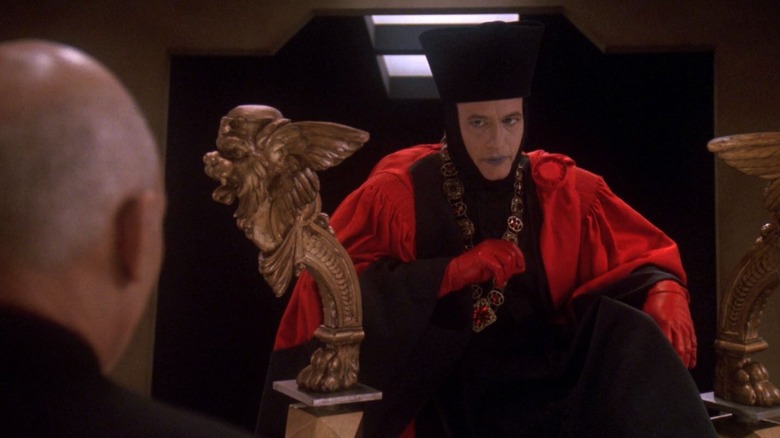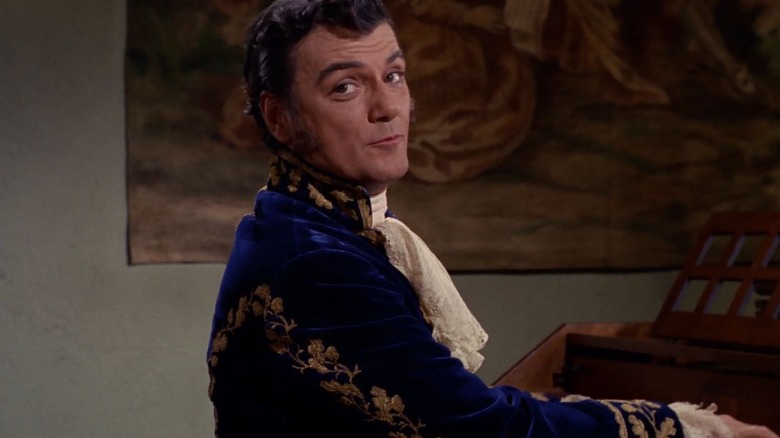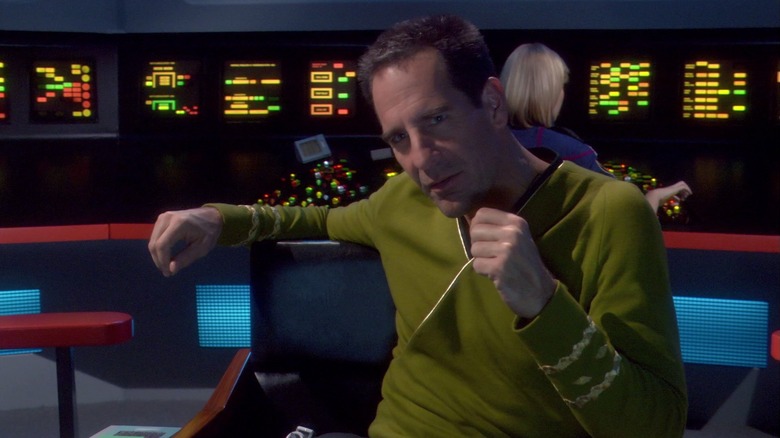The Q Fan Theory That Completely Changes Star Trek’s Multiverse

We may receive a commission on purchases made from links.
In the “Star Trek: Picard” episode “Penance” (March 10, 2022), Admiral Picard (Patrick Stewart) is visited by the impish cosmic deity Q (John de Lancie) for the first time in decades. Q, for reasons all his own, has decided to test Picard’s cleverness and resolve, and has orchestrated a little game for the Admiral. Q whisks Picard into a parallel universe wherein Earth is ruled by evil, xenophobic, genocidal tyranny. Picard finds that his parallel self is a mass-murdering general who keeps the skulls of his enemies in his den, and that all of Earth’s resources are now devoted to tracking down and killing other species. It’s pretty bleak. Picard finds that this evil timeline began sometime in the year 2024, and he gathers his compatriots to travel back and time to figure out what went wrong.
Advertisement
Curiously, the tyrant timeline in “Picard” isn’t quite the same as the mirror timeline seen multiple times throughout “Star Trek.” The mirror timeline was named after its first appearance in the original series episode “Mirror, Mirror” (October 6, 1967), an episode wherein several Enterprise crew members, thanks to an ion storm, were accidentally beamed into a parallel universe where everyone was evil. In that universe, Spock (Leonard Nimoy) had a goatee, assassinations were a common occurrence, and miscreants were punished with trips to the Agony Booth. The mirror timeline was revisited several times throughout “Star Trek” thereafter, including a few times on “Deep Space Nine” and regularly throughout “Discovery.”
Advertisement
Of course, in light of the tyrant timeline on “Picard,” Trekkies (who love to overthink things) might begin to ponder: If Q created the tyrant timeline — or at least granted Picard open access to it — did he perhaps do the same with the mirror timeline? After all, both are a great way to test the ethics of those from the “Prime” timeline. Was the Mirror Universe another test?
Did Q create the Mirror Universe?
The first time Trekkies saw Q, it was in the “Star Trek: The Next Generation” pilot, “Encounter at Farpoint” (September 28, 1987). In the episode, Q said humanity had ventured out into the galaxy quite far enough, thank you, pointing out that humans were, for the bulk of their history, a violent, warmongering species. Picard announces that humans are now peaceful and enlightened, so Q decided to test them. The events of “Encounter at Farpoint” were to be the first test. Q would return in subsequent episodes to keep the test going. Humanity had to prove they wouldn’t slip back into tyranny at a moment’s notice — that they weren’t motivated to worship autocrats just because, say, grocery prices began to rise.
Advertisement
In that light, one might be able to see the Mirror Universe as a multidimensional experiment conducted by Q. Perhaps Q created this universe (or at least subtly motivated its evolution) by letting humanity follow its basest instincts toward domination and violence. Q knows how terrible humanity can be, because he created what was essentially a “control group” of humans that leaned hard into torture and evil. When he heard Picard talk about how enlightened humanity was, Q was imminently skeptical, as he was just a godly snap of his fingers away from a version of humanity that loved to torture, conquer, and dominate.
Of course, in the “Deep Space Nine” episode “Crossover” (May 16, 1994), it would be revealed that, in the mirror timeline, humanity would eventually be overthrown. An evil version of Major Kira (Nana Visitor) explains that the visitation of Captain Kirk (William Shatner) to the Mirror Universe in “Mirror, Mirror” (set a century earlier) inspired a powerful military alliance between the Cardassians, the Klingons, and the Bajorans, forming an empire even more powerful than Earth’s. They conquered Earth and enslaved all humans. Perhaps that was the end result of Q’s experiment. If humanity was devoted to conquest, perhaps the only logical end result is being conquered.
Advertisement
To accept the theory, though, we also have to accept that Trelane was a Q
The human characters in “Crossover” are cowed, cowardly, and don’t have the bandwidth to exert evil over others. They were brought to hell. And of course, if “evil” humanity had been conquered in the Mirror Universe, Q would no longer use it as his control group. “Crossover,” not incidentally, aired concurrently with the final episodes of “Next Generation.” Perhaps Q’s appearance to Picard in the “Next Generation” finale was a way of “re-upping” his test of humanity’s ethics. He no longer had an “evil” version of humanity to prove his point, so the trial had to have some new parameters. It would also explain why Q had to create a second Mirror-like universe in “Star Trek: Picard.” With one version of “evil” humanity taken care of, he merely created another.
Advertisement
The “Q created the Mirror Universe” theory also dovetails with a popular Trek theory that Trelane (William Campbell), a godlike alien from the original series episode “The Squire of Gothos,” was an adolescent member of the Q Continuum. Trelane was obsessed with humanity, specifically its many historic wars. Trelane, however, was accidentally looking at Earth many centuries in its past, and assumed that the whole planet was still involved in global European colonialism … something he thought was delightfully and amusingly barbaric. When Trelane meets Kirk, he is dismayed to see that humanity has evolved into a peaceful society. It would eventually be revealed that Trelane is a child who viewed humanity as playthings. At the end of the episode, he was admonished by his “parents,” depicted as glowing balls of light.
Advertisement
Trelane is as impish as Q, leading some “Next Generation” fans to posit that he is indeed one of the same species. This theory was semi-confirmed by the (non-canonical) Peter David tie-in novel “Q-Squared.” And if Trelane was a young Q looking at humans at their most barbaric … could he have been looking into the Mirror Universe by mistake?
The opening credits to Enterprise offer an additional clue
As Trekkies know from the opening credits of the “Star Trek: Enterprise” episode “In a Mirror, Darkly” (April 22, 2005), the mirror timeline split from ordinary human evolution in 1705, about when the HMS Enterprize was first constructed. That episode took place entirely in the Mirror Universe, and the showrunners cleverly altered the episode’s opening credits to match the evil tone of a tyrannical humanity. Instead of being a montage of the history of exploration, it was a montage of the history of conquest. By the timeline of that opening credits sequence, humanity seems to have been following its usual history until about 1705, when the HMZ Enterprize was constructed. After that, it was all wars, destruction, and forced colonization.
Advertisement
If we’re to accept that timeline of the Mirror Universe, then it’s possible Trelane wasn’t looking into Earth’s past, but at the Mirror Universe. Because if Trelane was a Q, he would have had access to the ethics experiments that the Q Continuum was conducting, and any “evil” parallel universe they were overseeing. Perhaps Trelane’s obsession with Earth’s habits on conquest stemmed from his accidental glimpse into Q’s Mirror Timeline.
Of course, that theory would make “Mirror, Mirror” less interesting. It’s more thematically salient to point out that humanity was evil and tyrannical on its own — and that a distant alien would make assumptions about us — without the need for Q to create an entire evil universe. Maybe the “Q created the Mirror Universe” theory only holds water if we leave Trelane out of it.
Advertisement
Source link









